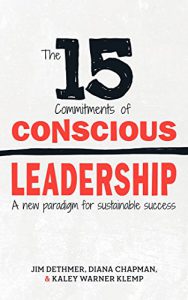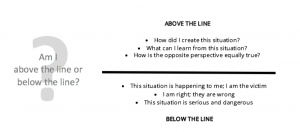I recently found myself in a spat with a colleague. In the heat of the moment, I felt a cocktail of defensiveness, judgment, annoyance, and anger that were all too familiar. With every new word from my colleague, a surge of emotions bubbled up in me. I sat there just waiting for my chance to retaliate, to justify my position.
In my mind, I had done everything I could to be reasonable and diplomatic. Yet still, I found myself in an argument where resolution seemed impossible. I felt trapped. I felt wronged.
“Am I below the line or above the line right now?”

According to Jim Dethmer, Diana Chapman, and Kaley Klemp—authors of “The 15 Commitments of Conscious Leadership: A New Paradigm for Sustainable Success” —this is the central question for aspiring and practicing conscious leaders.
Above the line is conscious. Below the line is unconscious.
But while the question itself couldn’t be simpler, the way of being it points to requires a lifetime of intentional practice.
To be below the line is to be closed, living from a place of defensiveness and needing to be right. This is how most of us (like me above) are in conflict. We feel wronged by a new policy from management, a manipulative coworker, the stock market, etc. and we create a story in which we are the victim. Life is happening to me.
To be above the line is to be genuinely curious about yourself and the dynamics you find yourself in. It is to be open, fundamentally focused on learning and growing, inviting every experience to be a lesson. The circumstances of my life are created by me.

Why is it important to be above the line?
According to Dethmer, Chapman, and Klemp, leaders that work from “above the line” experience a wide variety of practical benefits. They:
- Constantly develop new insight and skills
- Work with a sense of ease and flow
- Access deep wells of creativity
- Experience more fruitful and enjoyable work relationships
- Deftly balance work, play, and rest.
On top of all that, their behavior is contagious. Every conscious act offers a roadmap and inspiration for others to grow.
Conscious leaders are typically more effective at their jobs while enjoying themselves more. Sign me up.
The first steps in becoming a conscious leader
While conscious leadership is founded upon one simple model, there are many practices that cultivate consciousness. 15 Commitments outlines many of these. As the book progresses, these commitments become ever more complex and difficult to implement. Each one—from cultivating emotional intelligence to speaking candidly to recognizing that the opposite perspective is equally true—offers a new layer of our development.
But the first two commitments are arguably the most fundamental and the best starting point for aspiring conscious leaders.
First, take radical responsibility for your life circumstances. Ask yourself: “What if I am not ‘at the effect of the world,’ but rather actively creating my own circumstances? How did I create this situation for myself?”
Second, be curious and above all else committed to learning. Ask yourself: “What if these feelings of annoyance, anger, and pettiness are simply indicators that I can learn from this situation? What is the lesson here? Why did I create this situation for myself?”
All of a sudden, every seemingly toxic or negative situation is no longer a barrier, but actually the path to self-awareness and personal development.
Beyond “right” and “wrong”
In my recent conflict with my colleague, I was aware of these concepts and practices. I had read “15 Commitments” and quickly judged her as unconscious. ‘She is being unreasonable, petty, and not at all curious about my perspective!’ I convinced myself. So after a while, I said my piece and moved on.
That night, as the conversation spun around in my head, I felt shame creeping up inside me. As I asked myself that one fundamental question, it was immediately clear to me that I had not been genuinely interested in learning from the situation. In fact, I had used my judgment of my colleague as “unconscious” as a reason not to learn and be curious about the situation. What hypocrite!
But as I kept turning it over in my head, I found a new sense of liberation and release. Being unconscious didn’t make me “wrong.” It made me unconscious. And it therefore positioned me perfectly to learn, grow, and practice conscious leadership.
Perhaps the greatest insight of “15 Commitments” is that it’s not really about being “conscious” or “unconscious.” Being “conscious” is not a destination we can arrive at, but a process and commitment that we engage in continuously. And when we do, we open ourselves to a world of possibility, learning, and growth.






